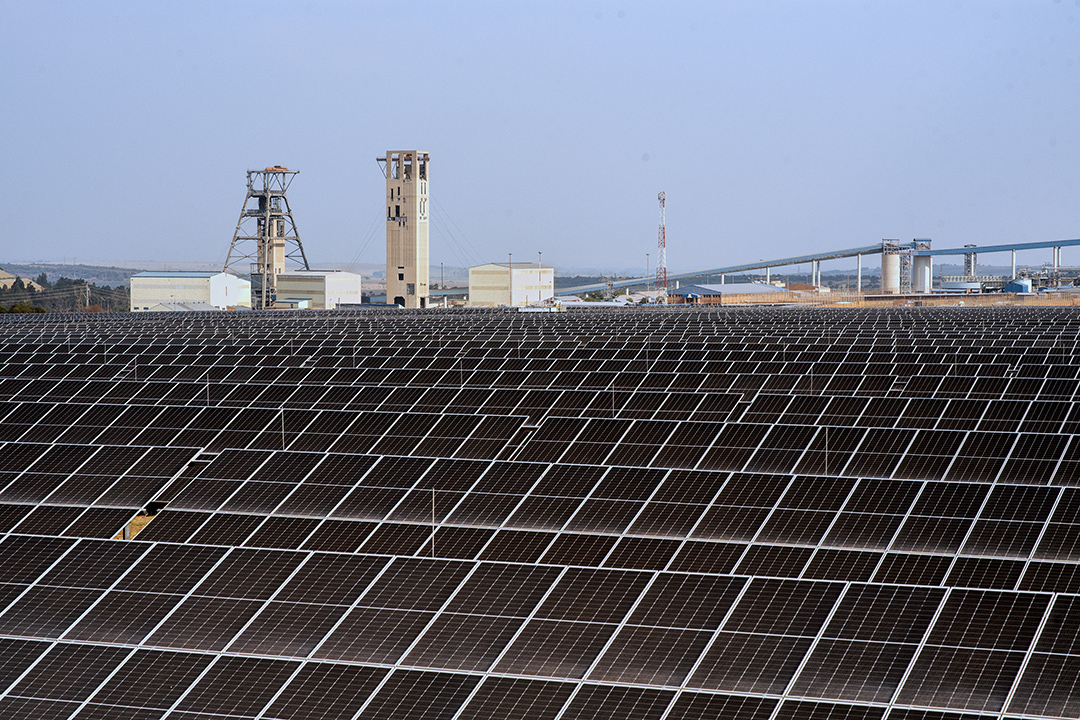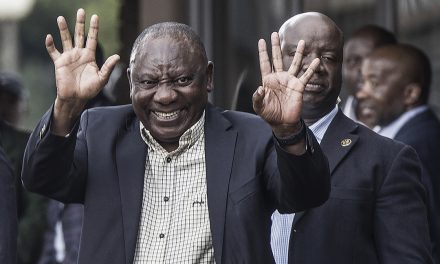Investec has described Finance Minister Enoch Godongwana’s 2023 budget speech as “walking a tightrope in providing financial assistance to Eskom, supporting households and increasing spending” and “credit-neutral”. The national energy crisis took centre stage in the speech, offering further details on Eskom’s debt relief and presenting incentives to promote renewable energy and electricity generation.
But several things have happened since then that potentially limit the effectiveness of the measures in the budget to address the energy crisis and the long-term sustainability of the country. These include South Africa being greylisted by the Financial Action Task Force, former Eskom chief executive Andre de Ruyter’s interview with Annika Larsen on eNCA, during which he made a number of allegations about corruption at Eskom, and S&P downgrading South Africa’s credit outlook from positive to stable.

This photograph taken on October 12, 2022, shows a general view of the new solar field in the background which provides electricity for Gold Fields South Africa company mines, in Westonaria, Gauteng. Photo: LUCA SOLA/AFP
Challenges with the consistent supply of electricity constrain economic growth. Load-shedding contributed significantly to South Africa’s GDP declining by 1.3% in the fourth quarter of 2022. This, in addition to direct economic losses through manufacturing shutdown and job losses, contributed to S&P’s decision.
According to the 2023 Budget Review by the treasury, South Africa’s public debt is expected to increase from R4.73 trillion in 2022-23 (71.1% of the GDP) to R5.84 trillion in 2025-26 (73.6% of GDP). Debt service costs, the costs associated with the repayment of a loan, are expected to increase from R307.2 billion in 2022-23 (4.6% of GDP) to R397.1 billion in 2025/26 (5% of GDP). Beyond 2025-26, the national debt is expected to decline. Nonetheless, R397 billion represents nearly a third of the national annual budget. This amount could otherwise be spent on health, education, infrastructure and more being done to address the energy crisis.
Eskom has struggled with high operational costs, corruption, poor management and neglected maintenance leading to constant breakdowns, which has resulted in the load-shedding that costs the country nearly R1 billion a day in foregone revenue. At the time of the budget speech, Eskom had a debt of R423 billion and had received R263.4 billion in bailouts from the treasury since the 2008-09 financial year. In addition, the government guarantees about R350 billion worth of Eskom’s debt, which would have been at risk of default had action not been taken.
To prevent a default, the treasury provided debt relief worth R256 billion over the next three years to improve the financial stability of the embattled utility and improve electricity availability in the country. R78 billion would be distributed to Eskom in 2023-24, R66 billion in 2024-25 and R40 billion in 2025-26, with the government taking over R70 billion of Eskom’s loan portfolio in 2025-26.
There is a risk that the Eskom bailout will end up being a sly subsidy for coal-fired electricity generation at a time when the country is actively engaged in the development of renewable energy generation.
The bailout has attached conditions that would ensure support for the unbundling of the national utility and focus on maintaining the existing grid infrastructure. But implementing these measures to maintain long-term financial stability and prevent the need for future bailouts raises questions. Currently, 96 of South Africa’s 278 municipalities owe Eskom over R56 billion between them. Municipal non-payment significantly reduces Eskom’s financial viability, forcing the company to borrow more to make up for lost revenue. Municipalities experience non-payment from customers, resulting in their non-payment to Eskom.
For Eskom to be functional, have operational viability in the long term and not require bailouts, the utility needs to be able to collect revenue from those it serves. The recent request by municipalities to challenge Eskom’s implementation of an 18.65% tariff approved by the National Energy Regulator of South Africa exposes the utility to significant risk and threatens efforts to bail out the utility.
Municipal non-payment actively contributes to the need for higher tariffs, as this results in a smaller pool of people paying for services, leading to those who are compliantly subsidising those who are not. In addition, there is a significant risk that those who can afford it will remove themselves from the national grid, causing further increases in the required tariff. Municipalities will further be burdened with the cost of servicing an increasing number of customers who cannot afford the price of electricity, creating a vicious cycle. Long-term thinking is critical to tackling the country’s electricity crisis and must include local municipalities or risk failing. Solutions could include the installation of prepaid electricity meters.
The slow pace of reforms to improve the infrastructure and governance of state-owned enterprises and their liabilities on the national debt were further contributing factors to S&P’s decision. De Ruyter’s interview supports the view that not enough is being done to improve governance in state-owned enterprises.
The Wits Southern Centre for Inequality Studies raises several concerns regarding the treasury’s approach to the Eskom bailout in terms of government accounting. The exclusion of payments to Eskom from the main budget balance means that there may not be an accurate accounting of the country’s debt. Budget oversight may also be further reduced. Creative accounting could be used for cash payments to other state-owned enterprises, hiding increased government borrowing and, in turn, increasing government liability.
In line with the objective of the national state of disaster declared during the State of the Nation address, the treasury proposed two tax incentives for renewable energy generation. The first is an expansion of the existing renewable energy tax incentive, which allowed businesses to deduct 100% of the costs of qualifying investments in renewable energy over one of three years. The expansion allows businesses to deduct 125% of the costs of all renewable energy projects in the first year, with no thresholds on generation capacity.
The second incentive allows individual taxpayers to deduct 25% of the cost of solar panels for rooftop solar installation, to a maximum of R15 000, from their taxes, and will only be available for one year. But the treasury has excluded inverters, installation costs and batteries, which are the most expensive components of solar electricity systems, from the incentive. This, and exclusively focusing on solar PV panels, has been criticised by the South African Photovoltaic Industry Association (SAPVIA). The treasury’s reason for the exclusion is that it wants to optimise the use of limited government funds to maximise generation capacity.
The problem with this approach is that while electricity production might increase, without storage, much of the electricity produced from solar photovoltaics will be wasted. Even with storage in place, the amount of solar electricity generated could potentially exceed household usage. To address this, it is essential that an attractive feed-in tariff is put in place, similar to the solution Vietnam used to end load-shedding in that country.
The following are the costs of rooftop solar in South Africa according to Nedbank:
- R55 000 to R60 000 for a grid-tied solar system which generates solar electricity but draws power from the grid when the system is not generating sufficient electricity. Grid-tied systems exclude batteries, which are often the most expensive part of solar power solutions. The average Freedom Lite lithium-ion 5kW battery costs almost R37 000.
- R 115 000 to R120 000 for a hybrid solar system with eight solar panels and two batteries. A hybrid system generates and stores electricity most of the time and draws power from the grid when necessary. Prices vary. As previously indicated, the inclusion of batteries increases the price of the solar system.
- R250 000 for an off-the-grid solar system with nine batteries and 14 solar panels. An off-the-grid system is independent of the national grid and corresponding outages.
The treasury’s bailout of Eskom has the potential to change the country’s energy landscape but implementing it will come with its own set of challenges and hurdles. The industry bodies and the treasury need to work together to develop sufficient measures as the incentive for promoting rooftop solar on an individual level is not enough due to the high cost of the systems. In addition, municipalities are crucial to solving the country’s energy crisis and making the treasury’s efforts fruitful.
The treasury needs to do more in these initiatives to support individual taxpayers to promote their energy security, while transforming Eskom into a world-class utility. Improving South Africa’s macroeconomic environment depends on addressing load-shedding and the mismanagement of state-owned enterprises more broadly.
This article first appeared in the Mail & Guardian on 22 March 2023.
Vincent Obisie-Orlu is a Natural Resource Governance researcher at Good Governance Africa. He holds a BA in International Relations and Political Studies from the University of the Witwatersrand. His work focuses on natural resource governance of critical minerals, Environmental Social and Governance (ESG) issues, sustainable finance, and energy policy in light of the energy transition.












